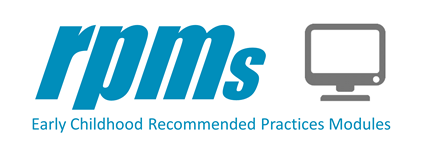Module 6: Instruction
Welcome to this Module on Instruction based on the Division for Early Childhood (DEC) Recommended Practices. In this module you will learn effective instructional practices and why intentional and systematic instruction is crucial for children with disabilities.
Learning Objectives
Completion of this module will enable you to:
- Explain what are instructional practices, describe how to how they support children’s learning outcomes
- Use strategies that are intentional, systematic that can support the four phases of learning
Each module developed by the Recommended Practices Module (RPM) project introduces and illustrates the practices grouped in one of the eight topic areas in the Division for Early Childhood (DEC) Recommended Practices. The DEC Recommended Practices were developed to provide guidance about the most effective ways to improve the learning outcomes and promote the development of young children, birth through five years of age, who have or are at-risk for developmental delays or disabilities.
Download: DEC Recommended Practices
Module 6 is aligned to the topic area of instruction and focuses on the following recommended practices:
Recommended Practices
-
INS1. Practitioners, with the family, identify each child's strengths, preferences, and interests to engage the child in active learning.
-
INS2. Practitioners, with the family, identify skills to target for instruction that help a child become adaptive, competent, socially connected, and engaged and that promote learning in natural and inclusive environments.
-
INS3. Practitioners gather and use data to inform decisions about individualized instruction.
-
INS4. Practitioners plan for and provide the level of support, accommodations, and adaptations needed for the child to access, participate, and learn within and across activities and routines.
-
INS5. Practitioners embed instruction within and across routines, activities, and environments to provide contextually relevant learning opportunities.
-
INS6. Practitioners use systematic instructional strategies with fidelity to teach skills and to promote child engagement and learning.
-
INS7. Practitioners use explicit feedback and consequences to increase child engagement, play, and skills..
-
INS8. Practitioners use peer-mediated intervention to teach skills and to promote child engagement and learning.
-
INS9. Practitioners use functional assessment and related prevention, promotion, and intervention strategies across environments to prevent and address challenging behavior.
-
INS10. Practitioners implement the frequency, intensity, and duration of instruction needed to address the child’s phase and pace of learning or the level of support needed by the family to achieve the child’s outcomes or goals.
-
INS11. Practitioners provide instructional support for young children with disabilities who are dual language learners to assist them in learning English and in continuing to develop skills through the use of their home language.
-
INS12. Practitioners use and adapt specific instructional strategies that are effective for dual language learners when teaching English to children with disabilities.
-
INS13. Practitioners use coaching or consultation strategies with primary caregivers or other adults to facilitate positive adult-child interactions and instruction intentionally designed to promote child learning and development.
